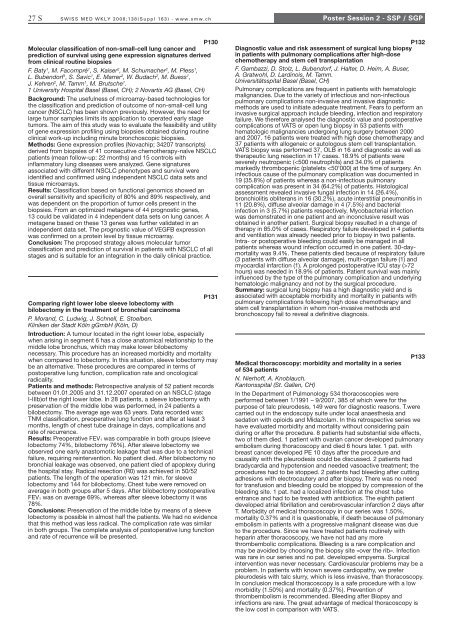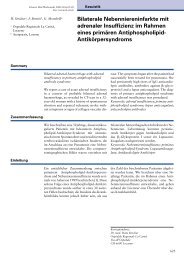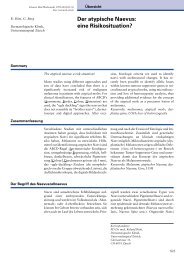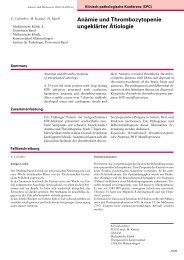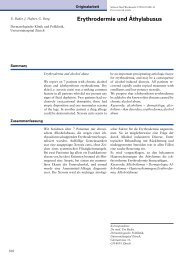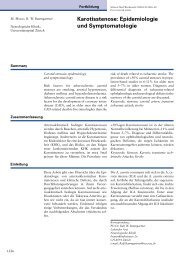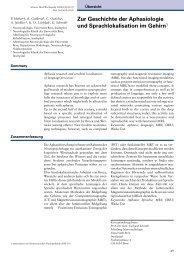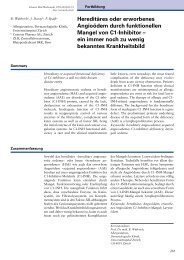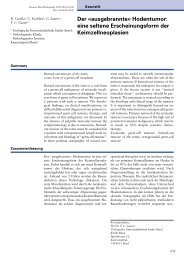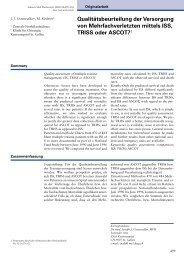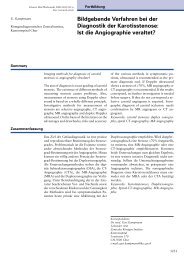Supplementum 163 - Swiss Medical Weekly
Supplementum 163 - Swiss Medical Weekly
Supplementum 163 - Swiss Medical Weekly
You also want an ePaper? Increase the reach of your titles
YUMPU automatically turns print PDFs into web optimized ePapers that Google loves.
27 S SWISS MED WKLY 2008;138(Suppl <strong>163</strong>) · www.smw.ch<br />
Poster Session 2 - SSP / SGP<br />
P130<br />
Molecular classification of non-small-cell lung cancer and<br />
prediction of survival using gene expression signatures derived<br />
from clinical routine biopsies<br />
F. Baty1 , M. Facompré1 , S. Kaiser2 , M. Schumacher2 , M. Pless1 ,<br />
L. Bubendorf1 , S. Savic1 , E. Marrer2 , W. Budach2 , M. Buess1 ,<br />
J. Kehren2 , M. Tamm1 , M. Brutsche1 .<br />
1 University Hospital Basel (Basel, CH); 2 Novartis AG (Basel, CH)<br />
Background: The usefulness of microarray-based technologies for<br />
the classification and prediction of outcome of non-small-cell lung<br />
cancer (NSCLC) has been shown previously. However, the need for<br />
large tumor samples limits its application to operated early stage<br />
tumors. The aim of this study was to evaluate the feasibility and utility<br />
of gene expression profiling using biopsies obtained during routine<br />
clinical work-up including minute bronchoscopic biopsies.<br />
Methods: Gene expression profiles (Novachip; 34207 transcripts)<br />
derived from biopsies of 41 consecutive chemotherapy-naïve NSCLC<br />
patients (mean follow-up: 22 months) and 15 controls with<br />
inflammatory lung diseases were analyzed. Gene signatures<br />
associated with different NSCLC phenotypes and survival were<br />
identified and confirmed using independent NSCLC data sets and<br />
tissue microarrays.<br />
Results: Classification based on functional genomics showed an<br />
overall sensitivity and specificity of 80% and 89% respectively, and<br />
was dependent on the proportion of tumor cells present in the<br />
biopsies. From an optimized metagene of 44 prognostic genes,<br />
13 could be validated in 4 independent data sets on lung cancer. A<br />
metagene based on these 13 genes was further validated in an<br />
independent data set. The prognostic value of VEGFB expression<br />
was confirmed on a protein level by tissue microarray.<br />
Conclusion: The proposed strategy allows molecular tumor<br />
classification and prediction of survival in patients with NSCLC of all<br />
stages and is suitable for an integration in the daily clinical practice.<br />
P131<br />
Comparing right lower lobe sleeve lobectomy with<br />
bilobectomy in the treatment of bronchial carcinoma<br />
P. Morand, C. Ludwig, J. Schnell, E. Stoelben.<br />
Kliniken der Stadt Köln gGmbH (Köln, D)<br />
Introduction: A tumour located in the right lower lobe, especially<br />
when arising in segment 6 has a close anatomical relationship to the<br />
middle lobe bronchus, which may make lower bilobectomy<br />
necessary. This procedure has an increased morbidity and mortality<br />
when compared to lobectomy. In this situation, sleeve lobectomy may<br />
be an alternative. These procedures are compared in terms of<br />
postoperative lung function, complication rate and oncological<br />
radicality.<br />
Patients and methods: Retrospective analysis of 52 patient records<br />
between 01.01.2005 and 31.12.2007 operated on an NSCLC (stage<br />
I-IIIb)of the right lower lobe. In 28 patients, a sleeve lobectomy with<br />
preservation of the middle lobe was performed, in 24 patients a<br />
bilobectomy. The average age was 63 years. Data recorded was:<br />
TNM classification, preoperative lung function and after at least 3<br />
months, length of chest tube drainage in days, complications and<br />
rate of recurrence.<br />
Results: Preoperative FEV1 was comparable in both groups (sleeve<br />
lobectomy 74%, bilobectomy 76%). After sleeve lobectomy we<br />
observed one early anastomotic leakage that was due to a technical<br />
failure, requiring reintervention. No patient died. After bilobectomy no<br />
bronchial leakage was observed, one patient died of apoplexy during<br />
the hospital stay. Radical resection (R0) was achieved in 50/52<br />
patients. The length of the operation was 121 min. for sleeve<br />
lobectomy and 144 for bilobectomy. Chest tube were removed on<br />
average in both groups after 5 days. After bilobectomy postoperative<br />
FEV1 was on average 69%, whereas after sleeve lobectomy it was<br />
78%.<br />
Conclusions: Preservation of the middle lobe by means of a sleeve<br />
lobectomy is possible in almost half the patients. We had no evidence<br />
that this method was less radical. The complication rate was similar<br />
in both groups. The complete analysis of postoperative lung function<br />
and rate of recurrence will be presented.<br />
P132<br />
Diagnostic value and risk assessment of surgical lung biopsy<br />
in patients with pulmonary complications after high-dose<br />
chemotherapy and stem cell transplantation<br />
F. Gambazzi, D. Stolz, L. Bubendorf, J. Halter, D. Heim, A. Buser,<br />
A. Gratwohl, D. Lardinois, M. Tamm.<br />
Universitätsspital Basel (Basel, CH)<br />
Pulmonary complications are frequent in patients with hematologic<br />
malignancies. Due to the variety of infectious and non-infectious<br />
pulmonary complications non-invasive and invasive diagnostic<br />
methods are used to initiate adequate treatment. Fears to perform an<br />
invasive surgical approach include bleeding, infection and respiratory<br />
failure. We therefore analysed the diagnostic value and postoperative<br />
complications of VATS or open lung biopsy in 53 patients with<br />
hematologic malignancies undergoing lung surgery between 2000<br />
and 2007. 16 patients were treated with high dose chemotherapy and<br />
37 patients with allogeneic or autologous stem cell transplantation.<br />
VATS biopsy was performed 37, OLB in 16 and diagnostic as well as<br />
therapeutic lung resection in 17 cases. 18.9% of patients were<br />
severely neutropenic (


